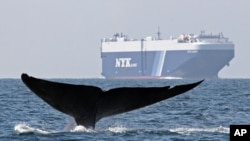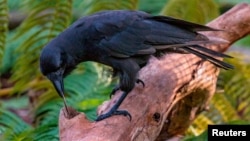As subfamilies of marine animal species — called genera — grow larger in body size, the likelihood of them being classified as threatened with extinction increases by an even greater amount, according to a study published Wednesday in the journal Science. In past extinctions, smaller creatures were more prone to die off, or size didn't matter, said study lead author Jonathan Payne, a paleobiologist at Stanford University. Almost none of the genera that have species averaging 0.4 inches (1 centimeter) long are threatened with extinction. However, 23 percent of those that are 3.9 inches (10 centimeters) are threatened, 40 percent of those that are 39 inches (1 meter) are endangered and 86 percent of those that are 32.8 feet (10 meters) are vulnerable, Payne said.

A blue whale is shown near a cargo ship in the Santa Barbara Channel off the California coast, Aug. 14, 2008. The oceans are turning into a Darwinian topsy-turvy place, where it’s survival of the smallest and the bigger a species is, the more prone it is to die off.
These are species that are not extinct yet, but are on the respected Red List of threatened and endangered species created by the International Union for the Conservation of Nature. “The proportion of species that are threatened increases enormously as body size increases,'' Payne said. Take the blue whale, not only the largest living animal, stretching close to 100 feet long, but the largest to ever have existed, Payne said. It's on the IUCN endangered list and has lost as much as 90 percent of its population in the last three generations, according to the IUCN. On the other end of the spectrum is a grouping of fish, bioluminescent bristlemouths, that are about three inches long. They are the most abundant creatures with a backbone; the population is estimated to be in the trillions.
Focus on oceans
Payne compared fossil records, looked at past mass extinctions and compared them to current threats, concentrating on 264 genera that have the best modern and ancient records. Payne concentrated on oceans, where the fossil records are better over time. The mass extinction 65 million years ago that killed off the dinosaurs didn't kill off bigger marine species at higher rates than smaller ones, unlike what's happening now, Payne said. The study “shows us how unusual this crisis of biodiversity we have right now,” said Boris Worm, a top marine scientist at Dalhousie University in Canada. He wasn't part of the study but praised it. “We have had mass extinctions before. This one is totally different than what has happened before.”

A 70-foot female blue whale, that officials believe was struck by a ship, is seen washed ashore near Fort Bragg, California, Oct. 20, 2009. As subfamilies of marine animal species grow larger in body size, the likelihood of them being classified as threatened with extinction increases by an even greater amount, according to a study published Sept. 14, 2016.
Worm spoke from a break during research in Canada's Bay of Fundy, where after a more-than-20-year career he finally saw his first underwater right whale and basking shark. “They are both in trouble and both among the largest of their kind,” Worm said.
Humans suspected


 The Science, Health, and Technology Room
The Science, Health, and Technology Room

 Reply With Quote
Reply With Quote






